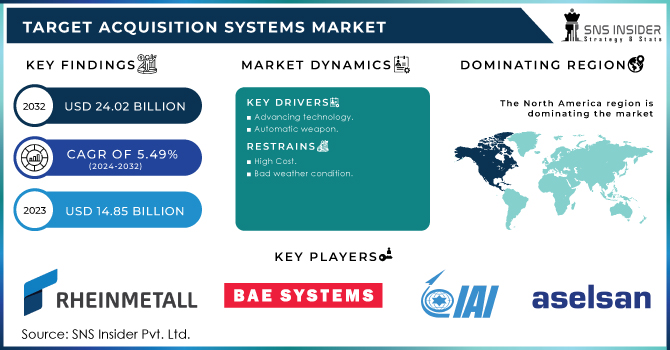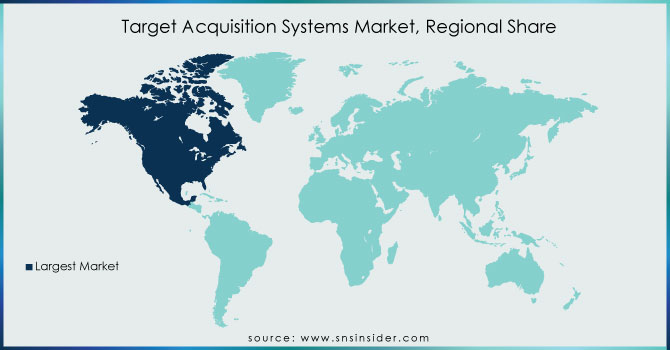Target Acquisition Systems Market Report Scope & Overview:

To get more information on Target Acquisition Systems Market - Request Free Sample Report
The Target Acquisition Systems Market size was USD 14.85 billion in 2023 and is expected to reach USD 24.02 billion by 2032, growing at a CAGR of 5.49% over the forecast period of 2024-2032.
Target acquisition systems are multi-purpose weapon systems that are used to identify, locate, and detect targets in order to employ lethal and non-lethal weapons effectively. An enemy commander can use a wide range of resources to conduct operations, including mobile and stationary units, forces, equipment, capabilities, facilities, people, and functions. Target acquisition, as opposed to surveillance on one and target tracking, is the process by which a weapon system decides which object to lock on to. Because of their increased use in intelligence, surveillance, and reconnaissance (ISR) missions, talent acquisition systems are in high demand. Target acquisition systems work in tandem with missile and bomb guidance mechanisms, as well as battlefield management systems. Advances in automatic weapons, increases in national defense spending, increased demand for artillery systems by military forces, and ongoing military modernization programs globally are some of the major factors predicted to drive the progress of the target acquisition systems market. The high operational cost of target acquisition systems, on the other hand, may limit the global target acquisition systems market's growth. Increasing investment in research and development (R&D) for the development of technologically advanced systems for defense applications, on the other hand, is an opportunity for the future.
MARKET DYNAMICS
KEY DRIVERS
-
Advancing technology
-
Automatic weapon
-
High budget
RESTRAINTS
-
High Cost
-
Hamper growth
-
Bad weather condition
OPPORTUNITIES
-
High revenue for the market player
-
Demand for artillery system
-
Investment in R&D sector
CHALLENGES
-
This is included in the final report.
THE IMPACT OF COVID-19
Due to the nature of the COVID-19, the procurement industries targeted for research and development worldwide, have been disrupted due to announced closures and government restrictions on public gatherings. The production rate of the target acquisition system is disrupted due to the COVID-19 epidemic. The supply chain for the remaining parts of the talent acquisition programs has also been adversely affected by the temporary closure of a few defense industries.
There will be a huge increase in demand in the global targeted acquisition systems market soon as the world moves towards normalcy. After COVID-19, the target acquisition system market could see significant growth as several countries have already ordered or planned to purchase their own systems for such systems.
By Range
The short-range (0–8 km) segment is expected to grow at the fastest CAGR during the forecast period. The expansion of the short-range segment can be attributed to the increasing demand for short-range target acquisition systems with higher accuracy than long-range artillery systems.
By Platform
The naval segment of the target acquisition systems market is expected to grow at the fastest CAGR during the forecast period, based on the platform. The acquisition of widely used target acquisition systems, such as destroyers, corvettes, frigates, offshore patrol vessels, unmanned surface vessels, and amphibious ships, has contributed to the growth of this segment.
By End-use
The military segment of the target acquisition systems market is expected to grow at a faster CAGR during the forecast period than the homeland security segment. The increasing use of unmanned surveillance systems is expected to drive demand for target acquisition systems used in ISR applications. The United States makes a significant contribution to military modernization programmers, and companies look to the United States because it has a large defense budget.
KEY MARKET SEGMENTATION
By Platform
-
Land
-
Airborne
-
Naval
By Sub-systems
-
Cameras
-
Scopes & sights
-
Detecting & locating systems
-
Modules
-
others
By Range
-
Short range
-
Medium range
-
Long range
By End-use
-
Military
-
Homeland
-
Security
Regional Analysis
The presence of prominent players and a large military budget are factors driving the target market's growth in North America. North America is expected to account for the majority of revenue over the forecast period. Furthermore, rising demand for target acquisition systems, particularly in the United States, is propelling the target market in this region forward. Asia Pacific is expected to account for the second-largest revenue share in the near future, followed by Europe, the Middle East and Africa, and Latin America. Increased defense budgets in countries such as India and China, as well as increased adoption of technologically advanced systems, are expected to drive growth in the target acquisition systems market over the next 10 years.

Need any customization research on Target Acquisition Systems Market - Enquiry Now
REGIONAL COVERAGE:
North America
-
USA
-
Canada
-
Mexico
Europe
-
Germany
-
UK
-
France
-
Italy
-
Spain
-
The Netherlands
-
Rest of Europe
Asia-Pacific
-
Japan
-
South Korea
-
China
-
India
-
Australia
-
Rest of Asia-Pacific
The Middle East & Africa
-
Israel
-
UAE
-
South Africa
-
Rest of Middle East & Africa
Latin America
-
Brazil
-
Argentina
-
Rest of Latin America
KEY PLAYERS
The Major players are Rheinmetall, BAE Systems, Israel Aerospace Industries, Aselsan A.S., Elbit Systems, Hensoldt, Leonardo, Raytheon Company, and Other Players
| Report Attributes | Details |
|---|---|
| Market Size in 2023 | US$ 14.85 Billion |
| Market Size by 2032 | US$ 24.02 Billion |
| CAGR | CAGR of 5.49% From 2024 to 2032 |
| Base Year | 2023 |
| Forecast Period | 2024-2032 |
| Historical Data | 2020-2022 |
| Report Scope & Coverage | Market Size, Segments Analysis, Competitive Landscape, Regional Analysis, DROC & SWOT Analysis, Forecast Outlook |
| Key Segments | • By Sub-Systems (Cameras, Scopes & Sights, Detecting & Locating Systems, Modules, Others) • By End-Use (Military, Homeland Security) • By Platform (Land, Airborne, Naval) • By Range (Short Range, Medium Range, Long Range) |
| Regional Analysis/Coverage | North America (USA, Canada, Mexico), Europe (Germany, UK, France, Italy, Spain, Netherlands, Rest of Europe), Asia-Pacific (Japan, South Korea, China, India, Australia, Rest of Asia-Pacific), The Middle East & Africa (Israel, UAE, South Africa, Rest of Middle East & Africa), Latin America (Brazil, Argentina, Rest of Latin America) |
| Company Profiles | Rheinmetall, BAE Systems, Israel Aerospace Industries, Aselsan A.S., Elbit Systems, Hensoldt, Leonardo, and Raytheon Company, among others. |
| DRIVERS | • Advancing technology • Automatic weapon • High budget |
| RESTRAINTS | • High Cost • Hamper growth • Bad weather condition |

